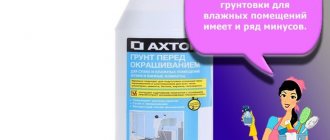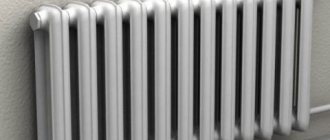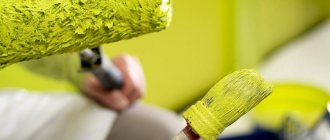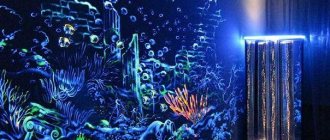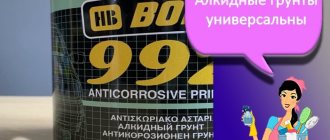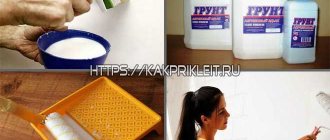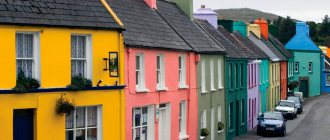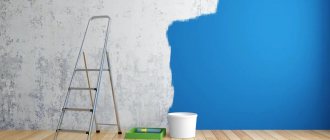By and large, there are two colors of mirror coatings, these are Silver and Gold, which have one common distinctive feature - the mirror shine of the surfaces being coated. Of course, such materials are most often used in the automotive industry and in the glass industry, although these are not all areas of use.
We will talk about this below, and also, as an addition, we will watch a thematic video in this article.
Mirror Chrome paint - excellent effect
Mirror paint: composition and release form
Paints with a mirror effect are available in aerosol cans, which simplifies the application of the composition to the prepared surface. The basis of this material is nitrocellulose varnish. At the production stage, this component is mixed with aluminum powder and other substances that ensure uniform distribution of the composition over the working surface.
Nitrocellulose varnish is responsible for creating a durable film. The mirror effect that characterizes this paint is provided by aluminum powder.
The final result that is obtained after drying of this material depends on the characteristics of the additional components. That is, the additives are responsible for ensuring that the base varnish lies evenly on the surface, and the aluminum powder forms a reflective layer.
Two-component paints
Two-component chrome paint (mirror) for metal and plastic is a composition that is made of two components: a base and a hardener. They are combined before dyeing and kneaded thoroughly. The excellent performance characteristics of the coating make these varieties the most popular.
Their positive properties include:
- absolute resemblance to polished metal;
- increased wear resistance;
- heat resistance.
Carrying out self-staining with two-component compositions requires a lot of time and effort, but the result completely justifies these sacrifices.
Scope of application
Paintwork with a mirror effect, as noted, is suitable for processing:
- metals;
- ceramics;
- plastic;
- concrete;
- wood;
- glass
In this regard, the scope of application of this dye is extensive. But more often this coating is used to process car body parts, mirror housings, and so on. The material can also be used for painting interior walls, decorative structures and other products.
Working methods for restoring a headlight reflector
We present two very effective methods that can really restore a damaged reflector surface. They are quite similar. The difference is rather in the material used, however, because of this, the method of pasting is different.
Metallized tape
You can buy foil tape in almost any construction supermarket. It has a glossy metallic surface. By the way, unlike conventional foil, it wrinkles much less, although creases may still remain.
The adhesive base of the described tape is quite strong and durable. Restored headlights using this material are able to adequately perform their functions for years.
Because foil tape, like other representatives of similar products. Made in the form of a tape in a roll, working with it is quite easy and convenient. You can cut fragments of any length and width. To carefully apply the layer, it is recommended to use a plastic spatula with a slightly rounded end. By smoothly smoothing the glued strip, you can avoid unnecessary creases and folds of the material. If there are still a few wrinkled places. They will not significantly affect the quality of the reflection.
Restoring reflectors in this way does not take much time. It is very important to clean and degrease the surface before starting work.
Mirror film oracal
As an alternative material for restoring the reflective surface of headlights, you can use a special Oracal film No. 351. It is very similar to a chrome surface in appearance. At the same time, it is quite flexible and elastic. Which is very convenient when working with it and gluing uneven surfaces.
The only difficulty is creating a high-quality stencil template. It will be useful for accurately cutting out the required shape of the film, which will accurately fit on a curved surface. The template can be created in two ways:
- the problem can be solved quickly and easily with a piece of paper;
- for those who like a perfect hit, you can make a stencil using papier-mâché, which is cut after drying.
Having cut out the necessary shapes, the parts are carefully glued, carefully smoothed with plastic spatulas and trimmed with a stationery knife.
Of course, there are other ways to restore the reflective surface of a headlight. The ones proposed above are simple but very effective methods of dealing with the problem that do not require special equipment, devices, knowledge and skills. Any car enthusiast who has ever used tape can do them.
Subscribe to topic
Notification by e-mail about replies to a topic during your absence from the forum.
Subscribe to this forum
Notification by e-mail about new topics on the forum during your absence from the forum.
Download/Print theme
Download the theme in various formats or view a printable version of the theme.
Chrome-plated items attract attention with their shine and high cost. And this is not surprising. Various parts, elements and accessories with their shiny surface give the interior of rooms, cars and other objects a special chic. This is why chrome paint is still widely used today in the design of any surface!
Advantages and disadvantages of use
The advantages of a dye with a mirror effect include the following:
- ease of application;
- ability to resist corrosion and mechanical stress;
- high adhesion;
- wide range of applications, not limited to one material;
- dries quickly;
- does not impose strict requirements on storage conditions.
Among the disadvantages of this dye are the following:
- the working surface must be carefully prepared before application;
- painting work cannot be carried out in a room where there are dust particles in the air;
- mirror aerosol is suitable for painting small surfaces.
Expert opinion
Zakharova Irina Yurievna
Cleaning professional with 15 years of experience. Our best expert.
Ask a Question
The main disadvantage of this paint is that, due to the characteristics of the composition, it is not always possible to obtain a mirror shine on the surface being treated.
This should also include the fact that colors often differ in tone saturation. That is, after treating the surface with two or more cans, one part of the material may be darker or lighter than the other. Therefore, it is recommended to purchase mirror paint from the same brand.
See also
Composition of primer enamels for rust, paint features and top 5 best brands
Powder mixtures
Mirror chrome paint of the powder variety is presented in the form of a crushed mixture, which includes hardeners, resins, various modifiers and pigment additives. The main advantages of this type include:
- Durability of the coating. The decorative layer is quite durable.
- High strength. The paint can withstand strong mechanical stress.
- Excellent decorative qualities. Powder formulations allow you to create a flawless mirror effect.
A significant disadvantage of such paints is the need for special equipment. To do the work with your own hands, the craftsman needs a heat treatment oven. You can do it yourself, but it will require additional time.
In general, the technology for applying such coatings is quite simple. The product must be thoroughly cleaned of debris and dust, degreased and treated with anti-corrosion compounds. Then a primer is applied to the surface to be treated, and after it dries, it is painted with mirror paint. It is applied by spraying. At the final stage, the finished product is sent to the oven.
Varieties
Regardless of the type of manufacturer, each mirror paint is available in the form of a one- or two-component composition.
One-component
One-component compositions are convenient because they are immediately ready for use: just shake the can, after which the material can be applied to the surface. Some manufacturers package such paints in cans.
One-component compositions are used mainly for treating small surfaces. This is due to the fact that this type of paint is not able to recreate a full-fledged mirror effect: the difference in shine compared to polished metal becomes immediately noticeable.
Single-component aerosols are difficult to apply. When working with such a paint coating, it is necessary to take into account many nuances on which the result depends. The disadvantages of such compositions include the fact that such materials dry quickly. Because of this, the paint does not have time to penetrate the surface structure, as a result of which the dried film peels off early and does not withstand mechanical stress.
In addition, single-component aerosols are characterized by high consumption.
Two-component
Two-component formulations differ from the previous ones in that they are produced mainly in cans. These products are based on acrylic or epoxy resin. The disadvantages of two-component compositions include the fact that the material must be mixed with a hardener before application. At the end of the work, the dried film must be painted with varnish.
At the same time, two-component compositions are able to recreate a mirror-like shine on the surface, comparable to polished metal. The dried coating is characterized by increased resistance to mechanical stress and heat treatment. In addition, two-component formulations are slowly consumed.
How did chrome paint come about?
Chrome products are ways to constantly attract attention with their incredible shine. The technology of chrome plating itself received rapid development only in the middle of the twentieth century. By the way, this type of coating is most widespread in the field of plumbing. With proper care, this type of item can always delight the eye with extraordinary brilliance and irresistibility. At one time, this composition became widespread in the automotive industry. This is especially true for North American automobile manufacturers dating back to the 1950s and 1960s. If you look closely at the cars of that time, you will notice that they practically shone like diamonds due to the abundance of chromium in their composition. Moldings, bumpers, side-view mirrors, a large number of overhead parts - all of this is covered with chrome, and aesthetically it looks very beautiful, and also provides an excellent anti-corrosion coating.
But such an effect was possible only when manufactured in a factory and under strict discipline to comply with complex technology. If there was even a slight deviation from the technological process, this threatened that the chrome would begin to peel off from the metal. At that time, there was also a drawback - chrome plating could only be applied to metal surfaces. Progress moves, does not stand still, and at the moment it is possible to chrome-plate all kinds of surfaces. However, real chrome plating even now remains the lot of enterprises and industries. This is directly related to the fact that the application of chromium metal is an electrical process. An alternative method of applying metallic chrome technology would be “chrome effect” paint. Here you can use two options at once - we are talking about the use of compositions using the most ordinary spray gun and liquid inside the cans. The first option can be divided into simple dyeing using a thermal treatment method.
Shade difference
The type of mirror paint shade is determined depending on the type of component with which the base varnish is mixed. More often, aluminum powder is used for such materials, which gives the surface a silver color. There are also compositions of other shades on the market:
- the combination of varnish and yellow metal allows you to obtain a golden dye;
- mixing aluminum powder and black translucent pigment allows you to get a dark coating.
Some paint manufacturers offer a tinting service. In this case, the final shade is determined depending on the type of pigment used.
Metal work
There are also two methods used to paint a car body. To use the first one, you need to proceed as follows:
- clean the surface from dirt and dry;
- fill the imperfections and rub problem areas with fine-grained sandpaper, completely remove all dust;
- prime the surface and wait for the composition to dry;
- apply a layer of black paint;
- polish the surface;
- Spray a thin layer of chrome plating material with a spray gun, dry and repeat the action the required number of times;
- The last stage is varnishing.
The second method of painting chrome with your own hands is popular among car owners. This is a good option if you need to paint alloy wheels, give them a fresh look and a mirror shine. For this, chrome powder paint is used. The material has high protective properties: it perfectly resists rust, is heat-resistant, and has a long service life.
The preparatory stage, as in the first method, begins with cleansing and ends with a primer. Next, powder dye is applied using a spray gun, and the part is placed in an oven where the material is polymerized.
Step-by-step instructions for use
The main difficulty when painting with mirror compositions is that the surface must be carefully prepared. In addition, such materials do not tolerate contact with dust and other contaminants. If small particles get into the material, then after drying there will be noticeable irregularities on the surface.
See also
How to quickly paint a metal fence, choice of composition and application rules
In this regard, work on painting materials with compositions with a mirror effect must be carried out in rooms with working ventilation, but without drafts. To finish the surface with such compositions you will need a spray gun. Depending on the type of material being painted, it is also necessary to prepare a plane, a hair dryer, a spatula and other tools.
Surface preparation
Regardless of the area of application of the dye, the surface must be washed and dried before starting the procedure. At the next stage, the following work is carried out:
- traces of rust or scale are removed (if metal is painted);
- the old coating is removed (this applies to any surfaces, including plastic and plastered walls);
- the surface is treated with a solvent to remove traces of grease;
- the surface is leveled using putty (if the walls are painted).
When working with wood, it is recommended to level the material with sandpaper or a grinder, gradually reducing the grain size. Plastic, unlike other materials, is damaged by old paint. In this case, coarse-grain sandpaper is also used to level the surface.
Upon completion of work, it is recommended to re-rinse the material. Finally, the surface is primed with a thin layer. If smudges appear, the applied material must be removed and this procedure repeated. If this is not done, noticeable defects will remain on the surface after painting.
Application technique
The technique for applying mirror paint is determined taking into account the type of material being processed. For plastic, the following scheme applies:
- The surface is painted black.
- The material is polished to a mirror finish and treated with alcohol.
- The painted plastic is heated using a hair dryer.
- Mirror paint is applied to the heated surface, which is then polished again after drying.
Plastic can also be painted according to the following scheme:
- The plastic is painted black, dried and varnished.
- The surface is re-dried and polished.
- Under high pressure, mirror paint is applied to the material, which is sprayed in a thin layer. This procedure can be carried out several times, depending on the effect that needs to be recreated on the surface.
- The material is placed in a special dryer heated to 60 degrees. Here the product must be kept for an hour.
- Three layers of fixing varnish are applied to the surface at intervals of 20 and 25 minutes, respectively.
- The plastic is dried and polished.
It is important that during the painting process, each layer of the applied composition (both paint and varnish) is completely dry. Otherwise, there is a risk of smudges and damage to the plastic.
See also
Technical characteristics of enamel KO-870, consumption per m2 and application methods
When working with metal, a different scheme is followed. This approach is mainly used when painting car bodies with mirror-like compounds. Metal processing is carried out according to the following algorithm:
- The material is cleaned, dried and polished. As part of these procedures, it is necessary to remove traces of rust and other defects, including unevenness, using sandpaper or a grinder.
- The metal is primed and dried.
- A layer of black paint is applied to the body metal, which is polished after drying.
- Using a spray gun, a thin layer of mirror paint is applied to the metal and dried. This stage can be repeated as many times as required to achieve the desired effect.
- The dried paint is fixed with varnish.
You cannot apply mirror paint with a brush or roller, as this will lead to the formation of smudges.
Drying time
Drying time depends on environmental conditions. At a temperature of +20 degrees, the paint gains sufficient strength within 24 hours after treatment.
Working with a plastic base
Mirror chrome paint (for plastic and metal surfaces) is applied to all materials in the same way - by spraying. But the technology for coloring products made of polypropylene and their analogues has its own characteristics.
The plastic product is pre-polished. This must be done to achieve ideal smoothness of the base. Next, a base coat of black paint is applied. After it dries, polishing is carried out again.
Before applying mirror paint, the base is heated using a hair dryer. The warm product is coated with a chrome plating compound using a sprayer. Please note that in this case it will not be possible to achieve perfect smoothness using a roller and brushes.
After the decorative layer has dried, a third polishing is carried out. If the painted surface requires additional protection, it can be coated with clear varnish.
Unusual effects and ways to design them
In addition to coloring, mirror paints are sometimes mixed with additional components during the production process, due to which the material becomes transparent after drying. However, with temperature fluctuations (increase or decrease), due to the characteristics of these substances, the dried material begins to acquire a given shade.
This type of dye is used more often when finishing automobile bodies. Such materials are divided into 2 types: some are capable of becoming transparent many times when exposed to temperature, others - once.
There are also dyes with a mirror effect, which contain substances that give the surface a matte shine. These materials are used mainly for finishing plumbing fixtures or furniture fittings.
One-component compositions
Single-component varieties are sold in the form of spray cans. Aerosol paints are quite easy to use and accessible to anyone.
The presence of a sprayer on the bottle eliminates the need to use complex equipment, which means that painting work does not cause difficulties. Aerosol mirror paint is used for metal, plastic and even wood. The low cost of the material makes this type of staining very popular.
- Weak imitation of chrome surface. It is rarely possible to achieve a good mirror effect using a spray can. Most often, the painted material takes on a light silvery tint.
- Features of applying aerosol compositions. Before you start painting, you should practice: select the optimal distance for spraying, determine the appropriate angle of inclination of the container.
- Small volume. Such paints are used for painting small items, since their quantity in one tube is minimal.
Most often, this variety is used in decorating small interior items and for painting automotive parts.
Sputtering technology
The principle of this effect is based on the fact that a darkened room is very difficult to see against the backdrop of a brighter reflection. To date, there are no translucent mirrors that would be able to transmit light in one direction and not in the other.
In order to make such glass, people began to use special methods that allow them to create products with a one-sided effect. Thus, ordinary mirrors are glass with a very dense and thick reflective coating applied to the back surface. Mirrors with one-sided transparency are made in a similar way, but a thinner coating layer that transmits light is used.
As an alternative, today a mirror film is often used, which is applied to the surface of the product. Such a mirror film can be easily applied to a finished product.
There are two main spraying methods:
- pyrolytic method (carried out at the manufacturing stage);
- vacuum-type spraying (applied to finished products using a special type of installation).
Today there are several types of vacuum deposition, the most popular of which are:
- magnetron high-speed;
- ion-plasma.
Magnetron sputtering
This type of processing involves applying various types of metals and their compounds to the surface of glass using the magnetron sputtering method. Products are processed in a closed space. This processing is carried out at the molecular level, due to which the products receive high quality and performance characteristics.
To achieve the desired effect, gases of various types are often used - oxygen, nitrogen or argon. During the reaction, layers of metals are formed on the surface of the product. This makes it possible to produce glass with various specified characteristics.
Glass tinted using magnetron sputtering technology has a number of advantages:
- excellent reflective characteristics;
- excellent heat reflection characteristics;
- thanks to the ability to simulate the thickness of the layer of applied metal, manufacturers can produce glass with the necessary characteristics of light reflection and light transmission;
- This type of coating can even be used for processing patterned glass.
- relatively low and affordable cost.
Ion plasma sputtering
To apply ion plasma sputtering, it is necessary to place the product under vacuum conditions. In a closed space there is an inert gas, cathodes with a negative charge and a metal coating, a positively charged anode, and a bearing with a triple liner.
During processing, the spray layer is applied specifically to the bearing. The plasma method makes it possible to apply alloys of a wide variety of metals, as well as their compounds, such as titanium, silver, aluminum, nickel, chromium, etc., onto the surface of products.
The quality of the coatings applied will always directly depend on the quality of the surface. In this case, even such points as the roughness or texture of the workpiece, the quality of preparation of the surface itself, and production culture are taken into account. It can be noted that the limiting factor that influences the spread of this method is the fairly stringent requirements for surface preparation, as well as the cost of the equipment used.
Sapphire-coated glass deserves special attention. In the watch industry, this technology is often used to create watch faces. The material used for production is mineral glass, which, in turn, is artificially grown from silicon oxide crystals.
For lovers of especially durable glass, craftsmen from Switzerland have learned to create glass even from artificial sapphires. Such products are characterized by high strength and no less high cost. The solution between strength and cost was found after the invention of mineral glass, which was coated with sapphire. This type of spraying has the strength of sapphire and the cost of ordinary mineral. The only drawback is the rapid abrasion period.
Technologies make it possible to apply high-quality tinting, low-emissivity, self-cleaning coatings to the glass surface, which can be effective to any given degree.
Coatings containing oxides are more durable than metal coatings. They are more resistant to external influences and are chemically related to glass.
How to make a mirror surface on glass at home
The ability to create mirrors with your own hands is a fascinating activity. Even though furniture stores are full of mirrors of every shape and size, creating something with your own hands brings special pleasure. From a practical point of view, this is even a useful activity. Because it can be useful in repairing optics and lighting devices containing mirror elements. However, this will require a separate room with the functions of a chemical laboratory.
Necessary materials
To work you will need the following elements:
- Goggles, rubber gloves, respirator;
- Vessels or containers for working with solutions, glass rod;
- Silver nitrate;
- Caustic potassium;
- Ammonia;
- Spray;
- The piece of glass is high quality, beautifully shaped, smooth;
- formalin in solution;
- Paint of any color;
- Chalk;
- Cuvette;
- Distilled water.
Useful: You can obtain silver nitrate yourself from an old silver coin by dissolving it in a 10% silver solution. Be sure to follow protective precautions when doing this.
Procedure
To create a mirror, the technique of chemical silvering of glass is used. First, you should properly prepare the glass surface of the future mirror, always holding it only by the edges so as not to leave stains on the smooth surface. For this:
- it is washed well on both sides, as well as the ends, with distilled water and crushed chalk;
- the entire area of the glass is degreased by wiping it with a napkin containing an alkali solution of 10 - 15% consistency;
- wash again with distilled water;
- dried;
- immersed in heated distilled water (the glass blank should be 10 degrees hotter than the silvering solution).
Next, a silvering solution is prepared. This is a two-step process:
- Stage one. Distilled water is mixed with silver nitrate in a proportion of 30 ml per 1.6 g. 25% ammonia is dripped into the resulting composition until the sediment disappears. As soon as there is no precipitate, add 100 ml of distilled water.
- Stage two, final. The resulting solution and 5 ml of formalin solution of 40% consistency are mixed. The solution for silvering is ready.
The glass is removed from the warm aqueous environment and placed on a special flask or cuvette. The silvering solution is poured into the middle and rolled out in an even layer using a glass rod. You can lower the glass blank directly into the solution, but so that the opposite side is not flooded with it. The chemical reaction takes three to ten minutes. After finishing, the resulting mirror surface should be washed with distilled water.
Next, the process of making the mirror continues with two hours of drying of the silver-plated surface. In this case, the temperature is maintained at a level of 100 to 150 degrees. The glass must be vertical. After the specified time has passed, the cooled surface is coated with transparent varnish using a spray bottle. If you get silver streaks, you should wipe them off with a cloth with a weak solution of nitric acid before applying the varnish. The silvering process is completed by horizontal drying of the mirror.
If the inner surface of the glass is endowed with the properties of a mirror, opaque paint of any color is applied on top of the silver layer. In order for the outer surface to serve as a mirror, the glass blank is kept completely lowered into a special container with a silver composition for 5-10 minutes.
Important: When working with chemicals, be sure to use goggles, a respirator and rubber gloves. It is forbidden to breathe the fumes of the resulting solutions. If it gets into eyes, rinse with clean water and consult a doctor.
